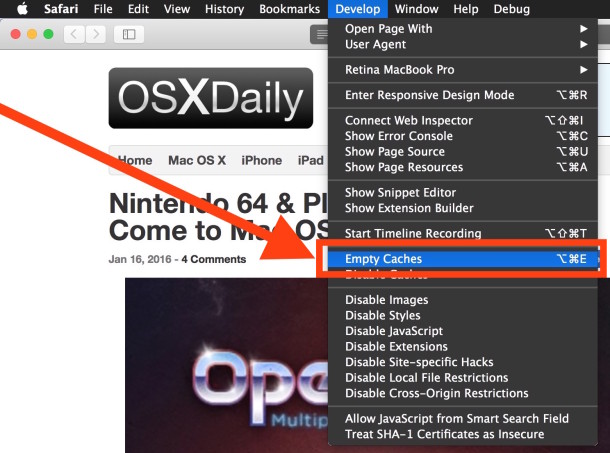

- #Empty cache in safari for mac os x how to#
- #Empty cache in safari for mac os x password#
- #Empty cache in safari for mac os x professional#
Just make sure to close or quit the browser and restart it after clearing cache. Then the safari cached will be cleared up on your Mac. In the drop-down menu of "Develop", select "Empty Caches". Then Click "Preferences" > "Advanced" to make "Develop" show in the upper menu bar.


#Empty cache in safari for mac os x how to#
Method 3: How to delete cache on Safari/Chrome/Firefox 1. So we will recommend you the method 1 to make clear cache on Mac permanently. In such situation, the deleted cache will go to Trash, and can be recovered with some data recovery software. Of course, you cannot clear most of folders in Caches with this method and you have no idea how much space they take and if those files can be deleted without app or system crash or freeze. To do that, you can control-click on the "Trash" icon and choose "Empty Trash." Then the cache files on Mac will be deleted. Step 4Type in "~/Library/Caches" and hit "Enter" key to clean up cache on Mac.Īfter that, you should navigate to "Trash" and empty the folder. Step 3Enter each of the folders and clean up cache files. Step 2Type in "/Library/Caches" and hit "Enter" key to proceed to this folder. Step 1Open "Finder" app on Mac and select "Go to Folder" in the "Go" menu. If you want to clear user cache and system cache on Mac, you can take the following guide. It can also help you to delete unneeded files and large and old files.
#Empty cache in safari for mac os x professional#
Mac Cleaner is a free and professional Mac data management tool to help you remove useless cache data and history quickly and safely. Method 1: Shortcut to clear cached on Mac automatically Method 3: How to delete cache on Safari/Chrome/Firefox.Method 2: How to clear cached on Mac manually.Method 1: Shortcut to clear cached on Mac automatically.If you don't know how to do it, you can keep reading to find the effective methods.

Here comes the question, how to clear cache on Mac? How to delete Safari and Chrome cache on Mac? In this post, we will show you 3 ways to empty browser cache files on Mac. You need to empty cache on Mac periodically. However, over time caches become bigger and bigger and will start slowing your Mac instead of making it work faster. It can bring you a better user experience, especially when you browse on Safari and Chrome. Cache is used to avoid recreating or re-downloading some information for the operating of system and apps. If you run one of the statistics commands, you should see a report pop up in your terminal window under the command line that looks something like this.How to Clear Cache on Mac (MacBook/iMac/Mac Pro/mini)Īlong with the daily usage of Mac, various caches will be piled up in the background. If you want statistics on your UDNS cache, use this command instead. However, it will let you know if it doesn't understand the command or if there's an error.įor those who just want to check in on their DNS cache, you can type the following command to get statistics on your MDNS cache. It will simply open up another command line below the one you just ran. If you are unfamiliar with Terminal, be aware that it will not alert you when it finishes clearing the cache. So, it should look something like this: sudo discoveryutil mdnsflushcache sudo discoveryutil udnsflushcaches You can type them in either order, as long as you separate the commands with a semi-colon. Or, if you want to save some time and clear everything out at once, you can string the two commands together in Terminal. To clear the UDNS cache, again in the Terminal window, type the following command and hit enter/return.
#Empty cache in safari for mac os x password#
If prompted, type in your password for your user account on your Mac. Once you have the Terminal window open, type the following command and hit enter/return to flush the MDNS. Let's start with clearing them separately. But, if you just want to fix the problem, they can both be flushed at the same time. This is helpful if you are trying to troubleshoot down to a more granular level. It's important to note here that Terminal will allow you to clear both the Multicast DNS (MDNS) and Unicast DNS (UDNS) using separate commands.


 0 kommentar(er)
0 kommentar(er)
